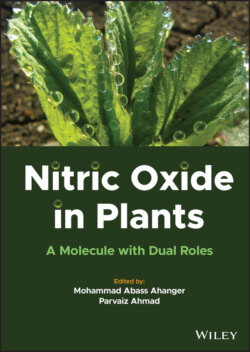Читать книгу Nitric Oxide in Plants - Группа авторов - Страница 11
1.2 The Function of Nitric Oxide in Plants
ОглавлениеNitric oxide is a common chemical molecule that is important in plant physiological activities. NO sources are useful in breaking dormancy and boosting seed germination in a variety of crops (Bethke et al. 2007; Giba et al. 2007; Prado et al. 2008; Albertos et al. 2015; Sanz et al. 2015). Similar research has been done to show the impact of organic nitrates in enhancing light-dependent and phytochrome-regulated germination in Pauwlonia tomentosa and Stellaria medium (Grubisic et al. 1992; Jovanovic et al. 2005). NO is involved in the regulation of catalase, ascorbate peroxidase, and aconitase activities (Clarke et al. 2000; Navarre et al. 2000), in cell wall lignification (Ferrer and Ros Barcelo 1999), the regulation of ion channels of guard cells(Garcia et al. 2003), mitochondrial and chloroplastic functionality (Yamaski et al. 2001), cell death (Pedroso et al. 2000), senescence (Hung and Kao 2003), accumulation of ferritin (Murgia et al. 2002), wound signaling (Orozco-Cardenas and Ryan 2002), cytokinin-induced programmed cell death (Neill et al. 2003), and abscisic acid (ABA)-induced stomatal closure (Neill et al. 2002). NO mediates maturation and senescence, operates on ethylene antagonism (Lamattina et al. 2003), induces increase of flavonoid production in Camellia sinensis L., and endogenous NO stimulates brassinosteroid (Li et al. 2017). Nitric oxide has a visible part to play in the formation of plant roots and shoots. It promotes root and plant development in many plants (Corpas et al. 2006, 2015). Controlling morphogenesis, growth, and development in plants requires targeted NO control (Hebelstrup et al. 2013). NO is primarily necessary for the establishment of plant–microbe interactions, which regulate N2-fixing symbiotic relationships and nodule senescence (Hichri et al. 2015). NO influences senescence in several plant species, including Arabidopsis, tobacco, pea, wheat, and others (Procházková et al. 2011), as well as flower formation in olive and Arabidopsis (Seligman et al. 2008; Zafra et al. 2010; Procházková et al. 2011). Nitric oxide is a crucial chemical in agriculture. It promotes seed germination, reduces postharvest losses by delaying fruit ripening, and improves the shelf life and quality of cut and detached flowers. NO also increases the activity of antioxidant enzymes in plants, which influences RNS and ROS metabolism (Corpas and Palma 2018).
